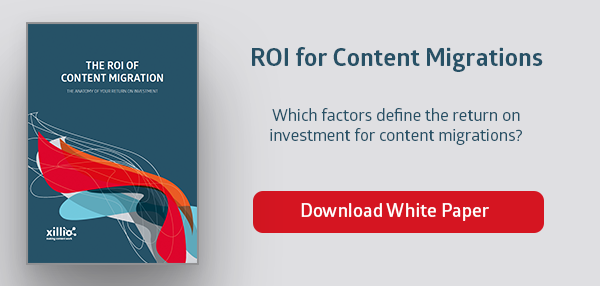Content migration project management requires a specialized approach distinct from traditional project management. According to Xillio CEO, Rikkert Engels, every project manager should ask these three essential questions before beginning a content migration project.
 1) How do I make sure this migration will be delivered on time, within budget, and with the desired outcome?
1) How do I make sure this migration will be delivered on time, within budget, and with the desired outcome?
Migrations are known to run out of time and budget. Three things can help you avoid this. First, ask around. Ask your peers how they have done it and use this input to your advantage. Second, do your research. Do not trust the shiny brochures from tool vendors or the “yes, you can trust me” from your solution partner. Migrations are hard. Don’t bet that you will be the 1% where it works right out of the box.
To make sure you think of all the details, we advise clients to go through a mental exercise comparing a migration to moving to a new house. Would you pick the first moving company you talk to? Would you allow them to dump everything in one place? Would you do reference checks? Would you contract them just because they have a shiny truck? Will they be able to get my laundry machine from the attic? How will they get your custom-made table through the door? You get the point. Think about your exceptions and think about how they can handle those.
2) How much time do I need to reserve for internal people?
One thing is certain. You can’t perform a migration in isolation. Even though partners might tell you, “just get it in the new system”. You will need the knowledge of content owners to – among others- tell you which content is valuable enough to transfer and to check the test migration. The amount of time needed from internal people is one of the toughest questions, as it completely depends on your migration strategy.
3) How do I know if I am paying a fair price?
The last thing you want as a project manager is to grossly overpay. Cheap sounds suspicious and too good to be true, and you certainly don’t want to pay too much. However, the most important element is that you try to get a grip on all the costs. There are several ways to conduct a migration.
Do it yourself, buy a tool, or outsource it? All come with pros and cons. But all come with additional costs that should be counted for. How much time is needed from internal people? How likely is an overrun? What is the impact of an overrun on internal costs? Licensing costs? Project management costs? Training costs? Support costs? Migration re-run costs?
Once you have a solid assessment of the most likely scenario and its possible consequences, you can estimate the costs and select the approach that best fits your project objectives. If you’re ready to take the next step or need expert guidance to ensure a successful migration, get in touch with Xillio today.
---------------------------------------------------------------------------------------------------
White paper: The ROI for Content Migrations
Download the white paper to read which factors can help define the return on investments for content migrations.

No Comments Yet
Let us know what you think